Exercise 5.9
- Some methods return values while others do not.
- What is the difference between the forms of the definition of
each of these kinds of methods?
- What is the difference between the calls to each of these kinds
of methods?
Explain the difference between an argument and a parameter.
What is the scope of a parameter of a method?
In the method outline shown here, state which variables can be used
at each numbered line.
public static int sample (int a, int b)
{ // 1
int c;
... // 2
for (int d = 0; .. )
{
... // 3
int e;
... // 4
}
... // 5
{
int f;
... // 6
}
int g;
... // 7
}
|
|
-
Write a definition of a method norm that has three double parameters,
x, y, and z. The method should return, as a double
value, the value of the expression [x2 + y2 + Z2]1/2
- For variables a, b, and c, write statements that use norm to assign
to the indicated variables the values of each of the following
expressions:
 Write a boolean-valued method isSquare with a single int parameter,
n. The method should return the value true if and only if n is
the square of some integer.
Complete the definition of the method digit with header
Write a boolean-valued method isSquare with a single int parameter,
n. The method should return the value true if and only if n is
the square of some integer.
Complete the definition of the method digit with header
public static int digit (int n, int position)
|
|
so that the method returns the value of the digit that is position
places from the right in the decimal representation of n. As examples,
digit (763,0) should return 3
digit (8574,2) should return 5
digit (78,4) should return 0
Write a character-valued method convertToGrade that has an int
parameter mark. The method should return the grade that corresponds
to mark according to the following table.
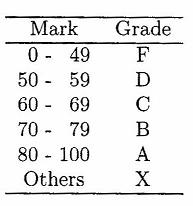 Write a method printTriangle that has a char parameter c and an
int parameter n. The method should print a triangular pattern with
the perimeter consisting of the character c and the interior (if there
is one) consisting of blanks. As an example, the call
printTriangle('*',5);
should produce output of the form
Write a method printTriangle that has a char parameter c and an
int parameter n. The method should print a triangular pattern with
the perimeter consisting of the character c and the interior (if there
is one) consisting of blanks. As an example, the call
printTriangle('*',5);
should produce output of the form
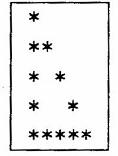 You may assume that the value of n is positive.
You may assume that the value of n is positive.
- Write a definition of a method leastFactor that has one int
parameter, n. If n > 1, the method should return the value of
the smallest prime factor of n; otherwise, it should return the
value zero.
- Write a program that uses leastFactor to find and print all
the prime factors of numbers read as input. For example, given
input of 12, the program should note that the prime factors are
2, 2, and 3. The program should be interactive, prompting the
user for values and processing them until a value less than one
is supplied by the user.
Write a method dayNumber that determines the number of days in a
year up to and including the current day. The method should have
three int parameters: year, month, and day. If the value of any
parameter is invalid, the method should print a warning message and
return the value zero. The table gives some examples of the action
of the method. Accept any non-negative year as being valid. You
may want to assume the existence of a method numberOfDays that
returns the number of days in a given month of a given year.
Triangles can be classified in a number of ways by considering the
relative sizes of either their sides or their angles. Using side classifications,
a triangle is equilateral if all sides are equal; it is isosceles if
exactly two sides are equal; it is scalene if no sides are equal. Using
angle classifications, a triangle is a right triangle if its largest angle
is a right angle; it is obtuse if its largest angle is greater than a right
angle; it is acute if its largest angle is less than a right angle. If the
sides of a triangle are known, Pythagoras' Theorem can be used to
classify the triangle as right, obtuse, or acute.
Write a program that will read an arbitrary number of sets of
three integers. The program should prompt the user for sets of numbers
and process them until the user submits the numbers 0 0 0. For
each set of three numbers, the program should first print the values
read. It should then decide whether or not the three numbers
could represent the lengths of the sides of a triangle. If the numbers
could not represent the lengths of sides of a triangle, an appropriate
message should be printed. If they could, then the program should
determine and state into which of the above classes the triangle would
be placed.
If the user provided input of
3 5 4
5 2 5
-7 1 2
0 0 0
then the program should produce output something like the following:
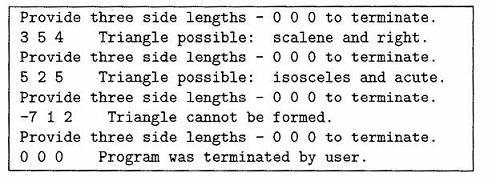 Nim is a two-player game in which players take turns picking up
sticks. The game begins with various numbers of sticks in a number
of piles. On any turn, a player must choose a pile and remove one or
more sticks from that pile (up to the number of sticks in the pile).
The object of the game is to force your opponent to pick up the last
stick in the last pile.
Write a program that allows two people to playa game of Nim.
The program should start by creating four piles of sticks, each with a
number of sticks that varies randomly from four to eight and displaying
the piles on the screen. The program should then prompt the first
player to remove a number of sticks from a pile. Once that player has
provided valid input, the program should then adjust the piles and
display the new configuration. This process should continue until one
player has won the game, at which time the computer should print
a congratulatory note to the winner. At the end of each game, the
computer should start a new game if the users state that they want to
do so. Once the users state that they are done, the computer should
print the number of games won by each player.
Pascal's triangle is a triangular array of numbers named in honour
of the French mathematician Blaise Pascal. The first few rows of the
triangle are:
Nim is a two-player game in which players take turns picking up
sticks. The game begins with various numbers of sticks in a number
of piles. On any turn, a player must choose a pile and remove one or
more sticks from that pile (up to the number of sticks in the pile).
The object of the game is to force your opponent to pick up the last
stick in the last pile.
Write a program that allows two people to playa game of Nim.
The program should start by creating four piles of sticks, each with a
number of sticks that varies randomly from four to eight and displaying
the piles on the screen. The program should then prompt the first
player to remove a number of sticks from a pile. Once that player has
provided valid input, the program should then adjust the piles and
display the new configuration. This process should continue until one
player has won the game, at which time the computer should print
a congratulatory note to the winner. At the end of each game, the
computer should start a new game if the users state that they want to
do so. Once the users state that they are done, the computer should
print the number of games won by each player.
Pascal's triangle is a triangular array of numbers named in honour
of the French mathematician Blaise Pascal. The first few rows of the
triangle are:
 The triangle can be extended as far as we please. The values of the entries
in any row can be obtained in a number of ways. One
way is to note that, in any row, the first and last entries both have
the value one while the value of each interior entry is the sum of the
values in the row above it, to its left and right. As examples, in the
last row shown, 6 = 1 + 5 and 15 = 5 + 10. The values can also be
obtained without reference to other values. If we let the symbol
The triangle can be extended as far as we please. The values of the entries
in any row can be obtained in a number of ways. One
way is to note that, in any row, the first and last entries both have
the value one while the value of each interior entry is the sum of the
values in the row above it, to its left and right. As examples, in the
last row shown, 6 = 1 + 5 and 15 = 5 + 10. The values can also be
obtained without reference to other values. If we let the symbol .JPG) represent the number of ways of choosing r items from n different
items, then the entries in the first few rows of Pascal's triangle are:
represent the number of ways of choosing r items from n different
items, then the entries in the first few rows of Pascal's triangle are:
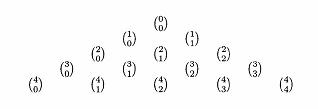 The value of
The value of .JPG) can be calculated using the formula: can be calculated using the formula:
 where the symbol n! is read as n factorial. The value of n! can be
found using the formula:
where the symbol n! is read as n factorial. The value of n! can be
found using the formula:
 Write a program that prints portions of Pascal's triangle. The
program should repeatedly ask the user to supply the number of rows
in the triangle, terminating when the user supplies the value zero. In
printing a triangle, the first value in the last row should appear in
the first column and each preceding row should start printing three
spaces further right. The number of spaces between entries in a row
should be adjusted so that values are aligned correctly from row to
row. For example, if the user supplies input of 7, the program should
print the following triangle. In the bottom row of the triangle, there
are five spaces between the first 1 and the first 6 but only four spaces
between the first 6 and the first 15. In this way, the last digit of 15
is aligned with the 4 and 1 above it.
Write a program that prints portions of Pascal's triangle. The
program should repeatedly ask the user to supply the number of rows
in the triangle, terminating when the user supplies the value zero. In
printing a triangle, the first value in the last row should appear in
the first column and each preceding row should start printing three
spaces further right. The number of spaces between entries in a row
should be adjusted so that values are aligned correctly from row to
row. For example, if the user supplies input of 7, the program should
print the following triangle. In the bottom row of the triangle, there
are five spaces between the first 1 and the first 6 but only four spaces
between the first 6 and the first 15. In this way, the last digit of 15
is aligned with the 4 and 1 above it.
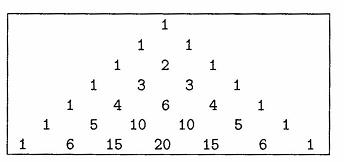 Your program should be able to print up to twenty rows of Pascal's
triangle. (Larger triangles contain entries that are more than five
digits long; they will not fit in the format specified for the problem.) If
a user specifies a number of rows greater than twenty or less than zero,
the program should reject the value gracefully. For large triangles,
your output device may not be able to print all the characters in
some rows on a single line. In such cases, the output of one row will
automatically wrap around to the next line. Do not worry about this
behaviour.
Your program should be able to print up to twenty rows of Pascal's
triangle. (Larger triangles contain entries that are more than five
digits long; they will not fit in the format specified for the problem.) If
a user specifies a number of rows greater than twenty or less than zero,
the program should reject the value gracefully. For large triangles,
your output device may not be able to print all the characters in
some rows on a single line. In such cases, the output of one row will
automatically wrap around to the next line. Do not worry about this
behaviour.
|
|